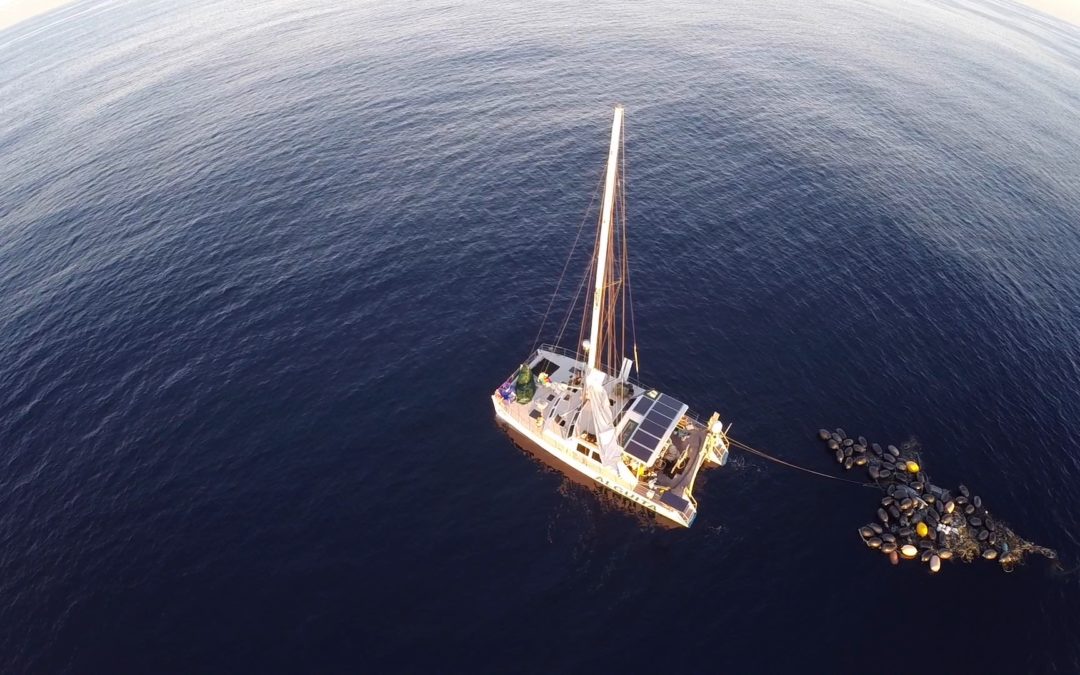We spent the night moored to the approximately 7 ton island of Hi-Zex brand buoys made by Sanshin Kako Ltd. The ropes dangling below the buoys were carefully spread apart and had scallop shells inserted, apparently as a recruitment site for oysters. When the tsunami hit on March 11<sup>th</sup>, 2011, it must have ripped out this array and sent it out to sea. We can thus date the time this island has been afloat; 3 years and 4 months. In addition to the buoys, the island is anchored by metal dangling from the ropes, perhaps part of the anchoring system for the shallow oyster aquaculture operation. Jesus and I mapped the island this morning using the dingy length of 10 feet and a tape measure to get its size and the dimension of its coves and rope beaches and reefs.
Before discussing the interesting aspects of this plastic island in the middle of the Pacific, it should be noted that this large floating object constitutes a significant hazard to navigation. It would be capable of causing considerable damage to even large ships. As such, I felt obliged to call any passing ships and inform them of the danger. The US Coast Guard issues Local Notices to Mariners for such things in US waters, but out here there is no entity to provide such information. I spoke to the motor vessels Nordpol and Ikan Jervius and the sailing vessel Avalon to warn them of the danger as they passed by. We do not have the equipment to either tow or dismantle and transport the island, so we will leave it as we found it more or less.
This massive ghost net supports large biological as well as plastic debris communities. Since it has been a fairly stable part of the gyre for years, it has an established fauna consisting of Gray chubs, large angelfish, Hawaiian sergeant, and Rainbow runner under and near the island and further away, Mahi Mahi or Dolphinfish. We found a live clam, several mussels, a shore crab and some seaweed and sponges among the matted ropes that make up the “beaches” of the island. We had been seeing Black footed albatross regularly before we arrived at the island and none recently. There is no guano on the island as there are no roosting birds in the area.
The plastic debris the island has accumulated is substantial, and we saw all the things we regularly pull up and then some. We got a dust pan for the ship, and Cynthia found a glass ball for her collection. Dr. Rios wanted some plastic fragments from the rope beaches of the island and Dale was able to surprise her with a 5 gallon bucket filled to overflowing with small plastic fragments like those that wash up on Kamilo Beach in Hawaii that I have been collecting for many years. There are over 17,000 meters of water underneath us and the highest spot on the island is about a meter and a half. For years I have been telling people that there is no such thing as a “plastic island” in the Pacific Gyre. I now have a map of one that has aspects of permanence, a metal anchor 40 feet deep, solid rope beaches, some of which you can walk on as if you were on land.
A sad note is that the jagged metal below the island has snagged monofilament gill nets with fish caught in them that have decayed, which we named the mausoleum. There are also driftwood logs caught in ropes. As far as I know, this is the first pelagic plastic island found floating in the North Pacific Gyre, with features that mimic hills, rocky coastlines, coves, beaches and ponds. In total area, it is about the size of our Oceanographic Research Vessel.

